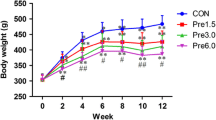Summary
Immature A/J mice were treated for up to 7 weeks with intermittent doses of triamcinolone hexacetonide and were thereafter allowed to recover for 7 weeks. Qualitative and quantitative morphological measurements were performed on the epiphyseal cartilage plate and diaphyseal bone of the humerus. By the third injection significant structural changes were noted in the cartilaginous tissue followed by a complete cessation of bone growth. The hormonal inhibitory effect on long bone growth lasted throughout the experimental period. However, at the end of the recovery period the length of the humerus was 96% of the normal. In contrast, the humeral width at midshaft and the width of its medullary cavity revealed slower recovery, achieving only 80% of the control values. Following rehabilitation, the growth of experimental epiphyseal plates exceeded that of nontreated animals as their width and the number of hypertrophic chondrocytes were 131% and 125% of their controls respectively. Thus, in A/J mice (a highly susceptible inbred strain of mice) intermittent (every four days) administration of a long-acting corticosteroid hormone arrested endochondral and periosteal bone formation; the former, however, underwent full recovery following the termination of the hormonal treatment.
Similar content being viewed by others
References
Baxter, J.D.: Mechanisms of glucocorticoid inhibition of growth. Kidney Int. 14, 330–333 (1978)
Bekhor, I., Mirell, C., Anne, L.: Induction of cleft palate by triamcinolone acetonide: re-examination of the problem. Cleft Palate J. 15, 220–232 (1978)
Dearden, L.C., Mosier, H.D., Espinosa, T.: Cortisone induced alterations of costal cartilage in single and in parabiosed rats. Cell Tissue Res. 189, 67–89 (1978)
Goldman, A.S., Katsumata, M., Jaffe, S.J., Gasser, D.L.: Palatal cytosol cortisol-binding protein associated with cleft palate susceptibility and H-2 genotype. Nature 265, 643–645 (1977)
Jelinek, R., Dostal, M.: Inhibitory effect of corticoids on the proliferative pattern in mouse palatal processes. Teratology 11, 193–198 (1975)
Mayer, M., Rosen, F.: Interaction of glucocorticoids and androgens with skeletal muscle. Metabolism 26, 937–962 (1977)
McDowell, E.M., Trump, B.F.: Histologic fixative suitable for diagnostic light and electron microscopy. Arch. Pathol. Lab. Med. 100, 405–414 (1976)
Pratt, W.B.: The mechanism of glucocorticoid effects in fibroblasts. J. Invest. Dermatol. 71, 24–35 (1978)
Rimsza, M.E.: Complications of corticosteroid therapy. Am. J. Dis. Child. 132, 806–810 (1978)
Salomon, D.S., Pratt, R.M.: Inhibition of growth in vitro by glucocorticoids in mouse embryonic facial mesenchyme cells. J. Cell Physiol. 97, 315–328 (1978)
Sheagren, J.N., Jowsey, J., Bird, D.C., Gurton, M.E., Jacobs, J.B.: Effect on bone growth of daily versus alternate-day corticosteroid administration; an experimental study. J. Lab. Clin. Med. 89, 120–130 (1977)
Silbermann, M., Kedar, T.: Quantitative changes in the cellular population of the growth plate of triamcinolone-treated mice. Acta Anat. (Basel) 98, 396–400 (1977)
Silbermann, M., Maor, G.: Mandibular growth retardation in corticosteroid-treated juvenile mice. Anat. Rec. 194, 355–368 (1979)
Silbermann, M., Kleinhaus, U., Livne, E., Kedar, T.: Retardation of bone growth in triamcinolone-treated mice. J. Anat. 121, 515–535 (1976)
Silbermann, M., Kedar, T., Kovat, P.: Priamcinolone-induced wasting disease in young mice. Acta Anat. (Basel) 97, 180–190 (1977a)
Silbermann, M., Kedar, T., Hornung, G.: Corticosteroid-induced changes in glucose metabolism of chondrocytes. Histochemistry 50, 327–335 (1977b)
Silbermann, M., Toister, Z., Lewinson, D.: Corticosteroid-induced enhanced mineralization in neonatal condylar cartilage. Clin. Orthop. 129, 293–298 (1977c)
Travis, L.B., Chesney, R., McEnery, P., Moel, D., Pennisi, A., Rotter, D., Talwalker, Y.B., Wolff, E.: Growth and glucocorticoids in children with kidney disease. Kidney Int. 14, 365–368 (1978)
Author information
Authors and Affiliations
Additional information
Supported in part by the Hy and Ann Natovich Orthopaedic and Rehabilitation Research Foundation
Part of this work was presented in abstract form at the Annual Meeting of the American Association of Anatomists, 1979
The authors are grateful to Miss Aviva Valensi, Miss Dorit Licht and Mrs. Pessia Shenzer for their excellent technical assistance
Rights and permissions
About this article
Cite this article
Silbermann, M., Levitan, S., Kleinhaus, U. et al. Long bone growth during prolonged intermittent corticosteroid treatment and subsequent rehabilitation. Cell Tissue Res. 201, 51–62 (1979). https://doi.org/10.1007/BF00238047
Accepted:
Issue Date:
DOI: https://doi.org/10.1007/BF00238047




